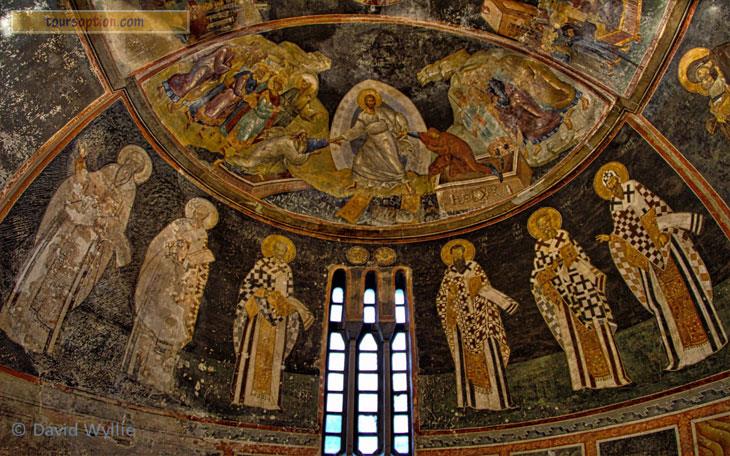
Chora Church
It is in Edirnekapı district in Istanbul. The meaning of the word Kariye (Khora) came to mean rural, out of town in ancient Greek. There is a chapel outside the walls of a very old castle in the sources. Instead of this chapel, the first Khora Church Iustinianos was reconstructed. Composed of various additions and repairs, the building reached to the period of the Commons, gained importance with the expansion of the Imperial Palace of Blakhernai near the walls. In the late 11th century, Maria Doukaina, the mother-in-law of Emperor Ilexios, rebuilt the church.
The church dome has a kiborion-shaped space that is carried by four arches. During the Latin occupation between 1204-1261, the monastery and the church became very devastated. II. In the period of Andronikos (1282-1328), the monarch and the church were restored to the monastery and the church in 1313 by Theodoros Metokhites, a man of letters, poets, and treasurers, and an exonarteks to the west and a parekklesion to the south were added. In addition, these attachments are adorned with mosaics and frescoes. The parekklesion, a narrow long single-nave chapel on the south facade, was built on a basement. The upper part is covered with a vault, the other part is covered with a vault. There is only one. The exonartext, which extends along the entire western front, forms today’s facade. The north wing is an insignificant corridor. The dome that covers the middle of the structure is of a high hoop. It has been repaired in the Turkish period and is wooden. In the outer facades, round arches, half piers, niches and stone brick loops are provided with a plastic and moving look. The eastern front ends with flooded apses. The middle apse is supported by a half arched strut on the outside.
In 1511, Vezir Hadim Ali Pasha converted the building which was used as a church for a while after the conquest of Istanbul. Then a school and a soup kitchen were added: Mosaic and fresco mosque was sometimes covered with wooden shutters and sometimes whitewash. From 1948 to 1958, all the mosaics and frescoes were uncovered at the end of the work of the American Byzantine Institute.
Kariye mosaics and frescoes are the most beautiful examples of Byzantine art in the last period (14th century). These mosaics and frescoes show a striking resemblance. The uniform fund of the previous period is not seen here. The idea of ??depth, the movement and plastic values ??of the figures, the elongation of the figures are characteristics of this style. The outer nartekste is the life of Jesus, while the inner nartekste is the stage of Mary’s life. There is a Pantocrator Jesus on the outer narthexter interior door. On the left is the birth of Jesus, the population census in front of the Governor Quirinus, the appearance of your angel to Joseph, the remembrance of Mary, the multiplication of bread, the transformation of water into a wine; On the right side there are staged scenes of the messianic kings telling the birth of Jesus, healing of the paralytic, and the children being massacres.
The most beautiful mosaic is Deisis when the interior nartek passes. Jesus in the middle, Mary on his left, Jesus on the bottom of Mary, Kommenos and a nun on the right hand of Jesus. This woman is VIII. Mikhael is the daughter of Palaiologos. She was married to the Mongolian Prince Abaka Khan and returned to Istanbul after her husband’s death and became a nun. In this section Jesus and the slices of Jesus on the dome are shown an ancestor. Jesus on the entrance to the main church was shown to offer the model of Theodoros Metokhites church, which restored the church on the left and decorated it with mosaics.
The life story of Mary, which is not included in the Bible, is taken from the apocalyptic ones. The inner nartekste is the birth of Mary, the first steps, the presence of Gabriel telling Mary that she will become a child, and the worship of the wool for the cover of the temple. On the inside of the main church is the death of Mary, the Virgin Mary carrying the child Jesus and a saint mosaic. All the parekklesion is decorated with frescoes. The Anastasis scene seen in Apsist is a masterpiece. The Last Hearing stage, located at the top of it, is shown here as a whole. The niches seen on the right and left of the Parekklesion are known to be graves. In the midst of the parekklesion dome is the image of Mary and Child Jesus, and 12 angels in the tongues.
Except Wednesdays, it is open every day between 09.00-16.00 hours.












